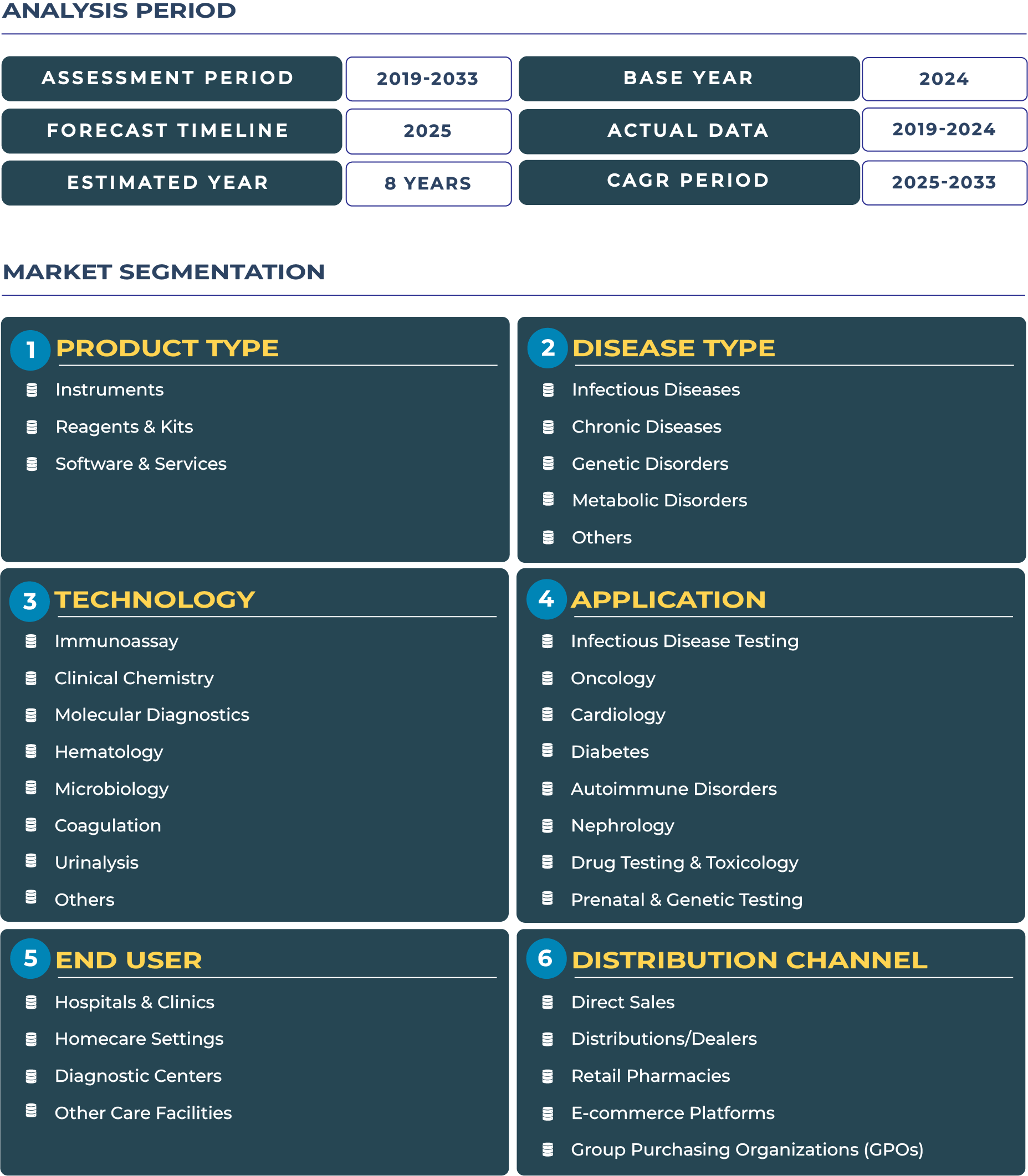Latin America In-Vitro Diagnostic Market Outlook: Reform-Driven Diagnostics for a Diverse Region
Latin America’s healthcare reforms and rising diagnostic awareness are steadily fueling the adoption of in-vitro diagnostics (IVD) across the region. Governments are pushing toward greater access, improved public health outcomes, and tighter disease surveillance, creating a fertile environment for diagnostic innovation. As reimbursement systems mature and private investment increases, the in-vitro diagnostic sector is harnessing this momentum to expand its footprint across Latin America’s heterogeneous markets.
The Latin America In-Vitro Diagnostic Market is estimated to reach USD 4.40 billion in 2025 and grow to USD 5.98 billion by 2033. This pace reflects the region’s dual challenges of economic volatility and opportunity in healthcare modernization. Brazil, due to its scale and healthcare infrastructure, continues to dominate the regional landscape, accounting for roughly major share of IVD revenues in recent years.
This growth is underpinned by reforms in public health systems, improved diagnostics reimbursement frameworks, and increasing private hospital investments. While adoption comes more slowly than in Asia, Latin America is aligning toward earlier disease detection, laboratory upgrades, and regional harmonization in regulatory practices. The expansion of multi-hospital chains and cross-border medical tourism corridors (e.g. to Colombia, Chile, and Peru) further enhances the case for scaling IVD infrastructure across the region.
Drivers & Restraints: Balancing LatAm Diagnostic Growth Against Structural Challenges
Drivers: Demographics, Private Investment & Medical Tourism Fuel Diagnostic Demand
The Latin American region boasts large populations concentrated in urban centers, many of which face rising burdens of chronic diseases such as diabetes, cardiovascular ailments, and cancer. This demographic shift elevates demand for routine and advanced diagnostic services. Private hospital chains, particularly in Brazil, Colombia, and Chile, are investing heavily in laboratory modernization and expanded diagnostic portfolios. Additionally, medical tourism corridors are gaining traction, with neighboring countries attracting patients for specialized interventions and associated diagnostic services.
Restraints: Currency Volatility, Budget Constraints & Fragmented Procurement Limit Scale
Despite momentum, Latin America in-vitro diagnostic market contends with persistent headwinds. Currency volatility and inflation erode margins for imported instruments and reagents, pressuring localized pricing. Public sector budgets remain constrained, often prioritizing essential care over diagnostics. Moreover, procurement remains fragmented across states and municipalities, complicating national rollouts. Differences in regulatory pathways across countries add complexity for multinational IVD firms seeking regional scale.
Trends & Opportunities: Evolving Strategies for Latin America’s Diagnostic Future
Trend: Local Manufacturing & Regional Hubs Steer Towards Supply Chain Resilience
Countries with existing diagnostic manufacturing capacity, such as Brazil and Argentina, are expanding reagent and kit production to reduce dependency on imports. For instance, Brazil is emerging as a regional manufacturing hub for IVD reagents, leveraging its industrial base to supply neighboring markets. This trend supports cost reduction, supply security, and improved lead times across Latin America. Developing regional hubs also enables faster regulatory alignment and service support for remote geographies.
Opportunity: Tiered Pricing, Public, Private Partnerships & Diagnostic Bundling
To bridge affordability gaps, IVD firms are designing tiered pricing models, offering basic, mid-tier, and premium test options tailored to public and private segments. Collaborations with governments and hospital networks allow scale-out of screening programs at subsidized rates. Bundling diagnostic services with orthopedic device procurement or surgical procedures (e.g. pre-op labs, post-op monitoring) fosters adoption synergies. Diagnostic firms that align with health ministries, deploy shared clinical trials, and offer value-based packages will gain competitive advantage across Latin America.
Regional Country Insights
-
Brazil
Brazil leads the Latin American IVD market in both scale and complexity, supported by its unified public system (Sistema Único de Saúde, SUS). Its robust manufacturing infrastructure, high adoption of molecular diagnostics, and regional export ambitions underpin its dominance. -
Peru
Peru is expanding diagnostic capacity in Lima and key regional cities. Efforts to decentralize laboratory services and adopt automated platforms are underway to reduce reliance on central labs. -
Colombia
Colombia’s emergent diagnostic infrastructure benefits from private hospital expansion and medical tourism. Its regulatory environment is converging with advanced standards, improving adoption of higher-end IVD offerings. -
Chile
Chile’s public health system has invested in laboratory network upgrades and digital connectivity, making it a testing ground for point-of-care and molecular diagnostics in emerging markets.
Competitive Landscape: Strategies for Regional Success and Scaling Diagnostics
The Latin American in-vitro diagnostic sector features both global corporations and local champions. Major names in the region include Roche Diagnostics, Abbott Laboratories, Siemens Healthineers, and Brazil’s DASA (Diagnósticos da América). DASA operates one of the largest diagnostic networks in Latin America, integrating clinical laboratories, imaging services, and genomics.
Successful strategies include establishing regional distribution hubs, leveraging regional clinical trials, and offering bundled diagnostic packages tailored to local epidemiologies. Many firms also pursue joint ventures with national hospital groups to secure long-term contracts and mitigate regulatory risks. For example, Roche and Abbott increasingly partner with private hospital chains to pilot new molecular assays under local reimbursement frameworks. The reliance on reagent-based revenue models underscores the importance of local supply and logistics excellence.








